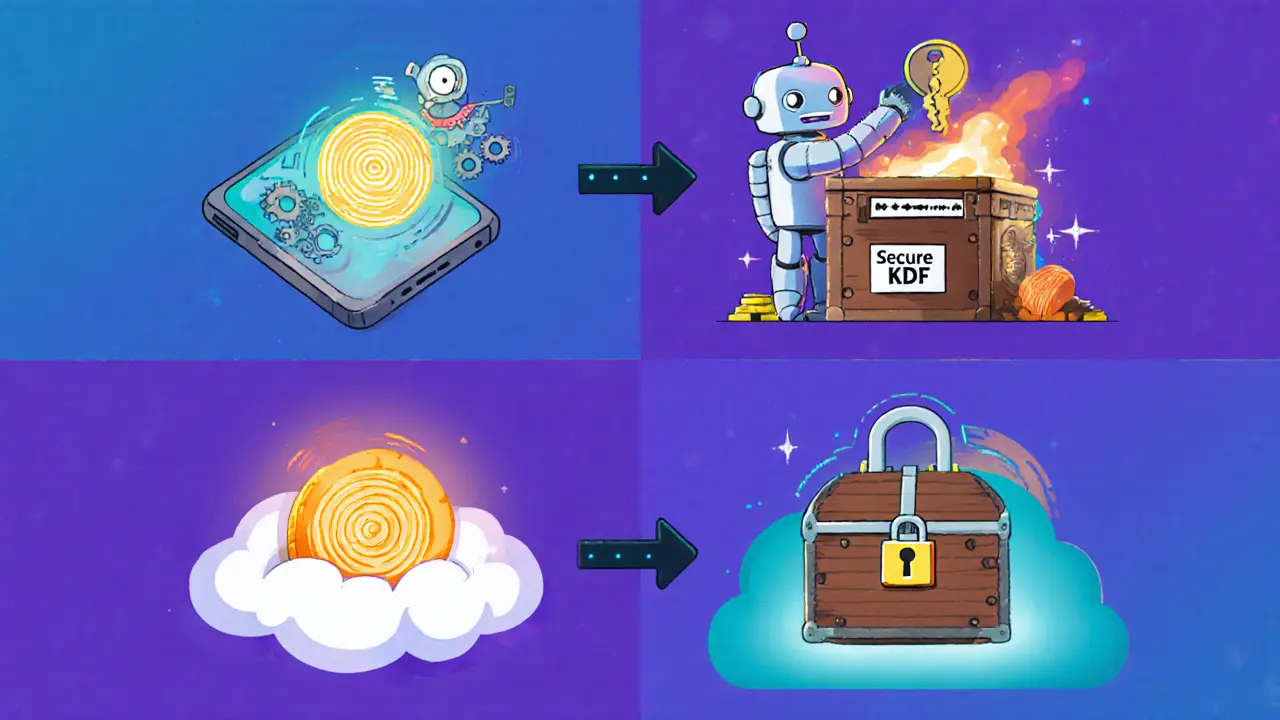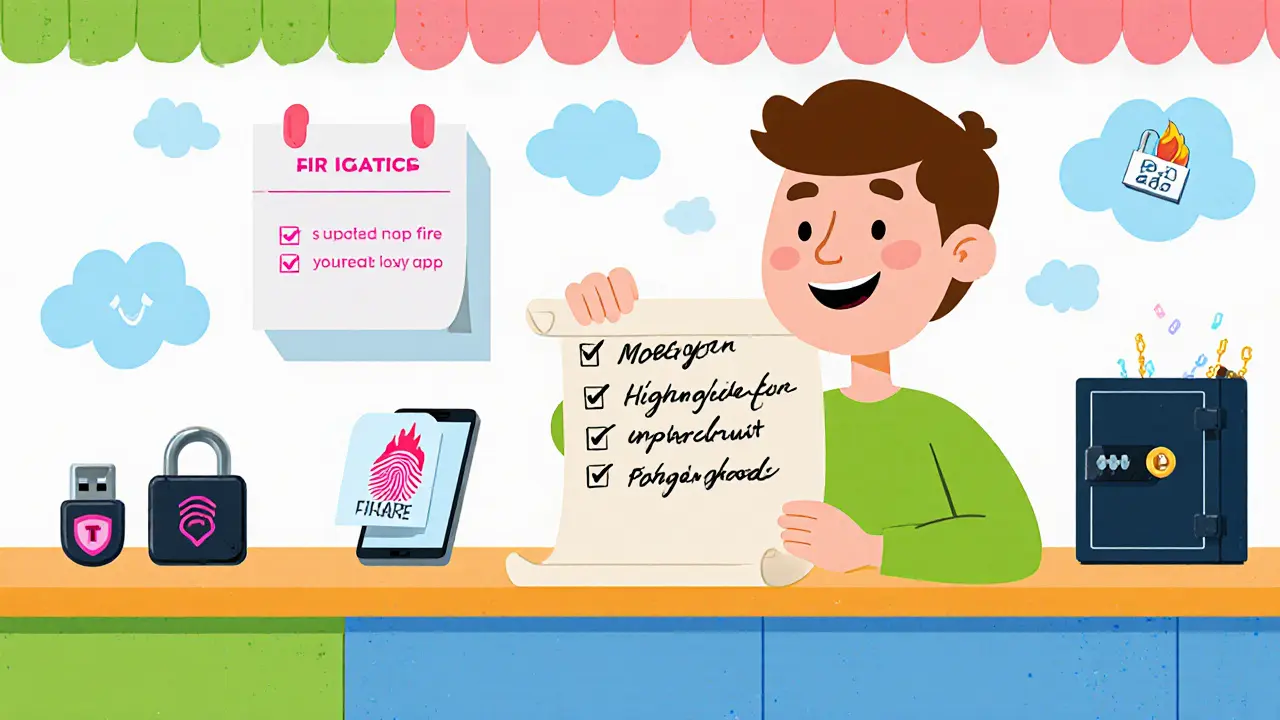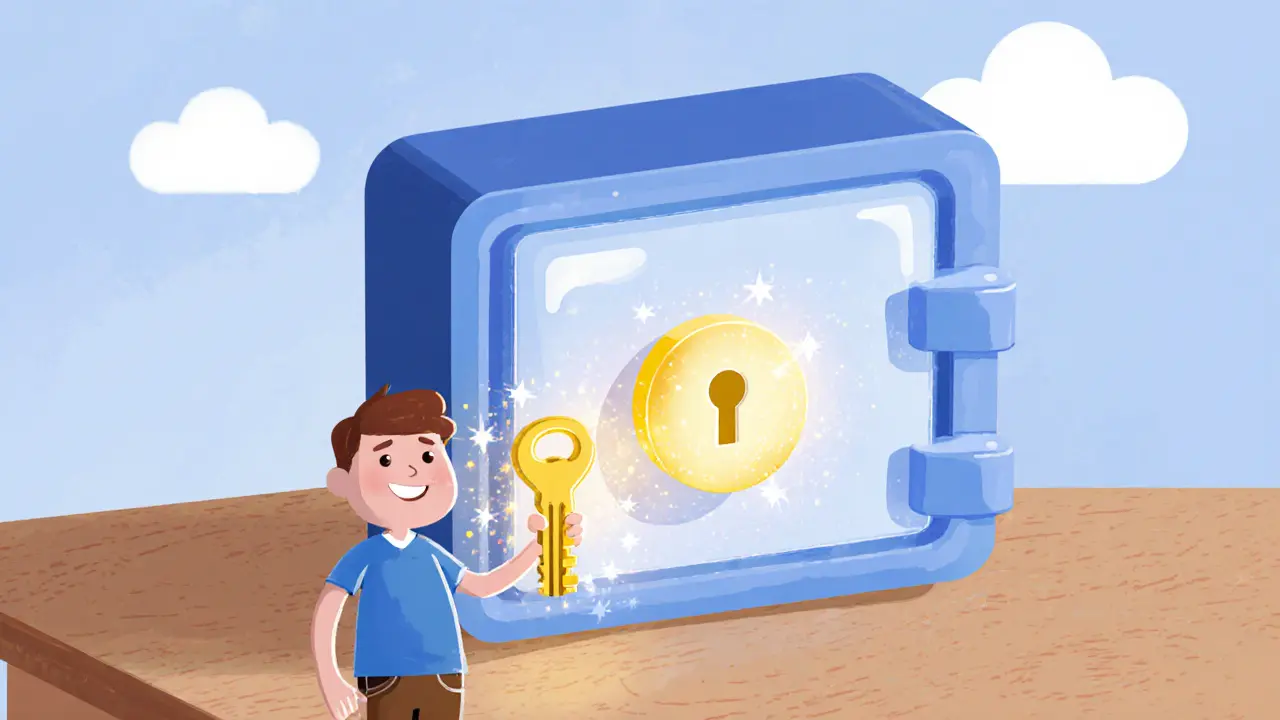Crypto Wallet Security Checker
Answer the following questions about your wallet's security features to determine if it implements end-to-end encryption properly:
Answer the questions above to see your security assessment.
When you hear end-to-end encryption, think of a vault that only you can open - even the vault maker never sees the key. In the world of crypto wallets, that vault is the private key, and the vault’s lock is the encryption that protects it from anyone else on the internet.
Key Takeaways
- Private keys are generated and never leave your device.
- Passwords are turned into strong encryption keys with Key Derivation Functions (KDFs).
- Encrypted data stays encrypted whether stored locally or in the cloud.
- Only you can decrypt the wallet on your device; no server ever sees the plaintext.
- Emerging tech like Multi‑Party Computation and hardware security modules further raise the bar.
What Is End-to-End Encryption?
End-to-End Encryption is a communication‑security method where data is encrypted on the sender’s device and only decrypted on the recipient’s device. The encryption stays intact while the data traverses networks, making it unreadable to any intermediate party. The concept originated in messaging apps, but its principles map perfectly onto crypto wallets because the “message” is the private key and transaction data.
How E2EE Works Inside a Crypto Wallet
The process breaks down into four clear stages, each designed to keep the private key out of sight:
- Local Key Generation: When you first create a wallet, the Crypto Wallet generates a private key and recovery phrase directly on your device. No data is sent to a server.
- Local Encryption: Your chosen password is fed into a Key Derivation Function (KDF) such as Argon2 or PBKDF2. The KDF outputs a strong, unique encryption key that locks the private key and seed phrase.
- Secure Encrypted Storage: The encrypted blob can sit on your phone’s secure element, a hardware‑encrypted folder, or even a cloud backup service like iCloud. Crucially, the blob never becomes plaintext again.
- Local Decryption: Whenever you open the wallet, you re‑enter your password. The KDF regenerates the decryption key, unlocks the blob, and the private key lives only in the app’s memory - never over the network.
This flow guarantees that the private key never touches the wire, a core reason why E2EE is considered the gold standard for wallet security.
Core Cryptographic Components
Understanding the building blocks helps you evaluate any wallet’s E2EE implementation.
- Private Key is a 256‑bit number that signs transactions. Losing it means losing access to every coin stored in the wallet.
- Recovery Phrase is a 12‑ to 24‑word mnemonic that can rebuild the private key. It must be kept offline.
- Key Derivation Function converts a human‑readable password into a cryptographically strong key. Argon2, scrypt, and PBKDF2 are common choices.
- Hardware Wallet stores private keys in a tamper‑resistant module and signs transactions without exposing the key. Devices like Ledger and Trezor pair well with E2EE apps for extra isolation.
- Biometric Authentication uses fingerprint or facial data to unlock the decryption key locally. It adds convenience without compromising the underlying encryption.
- Multi‑Party Computation splits private‑key operations across multiple devices or servers, ensuring no single point ever sees the whole key. Still emerging but promising for high‑value holdings.

Why E2EE Beats Custodial Solutions
Custodial wallets keep your private key on a remote server. If the server is hacked, every user’s keys are exposed in one fell swoop. Non‑custodial wallets that employ E2EE eliminate that single point of failure.
| Aspect | Custodial Wallet | Non‑Custodial E2EE Wallet |
|---|---|---|
| Key Storage | Server‑hosted private keys | Private key generated & stored only on user device |
| Control | Third‑party can move funds | User retains sole signing authority |
| Attack Surface | Single server breach risks many accounts | Each device isolated; breach affects only that device |
| Recovery | Provider can reset passwords | Recovery phrase mandatory; no provider reset |
| Regulatory Compliance | Often KYC/AML enforced | Typically self‑custody, lighter KYC requirements |
Bottom line: E2EE gives you ownership, but it also puts the onus of security squarely on you.
Balancing Security with Usability
Great security tools fail if users can’t operate them. Crypto wallets tackle three usability hurdles:
- Recovery Phrase Management: Users must write the phrase on paper, store it in a safe, and never digitize it. Some apps offer “social recovery” where trusted contacts hold encrypted shares.
- Password Strength: Weak passwords undermine even the strongest KDF. Wallets now suggest passphrases with at least 12 characters, mixing upper‑, lower‑case, numbers, and symbols.
- Device Compatibility: Mobile wallets need fast encryption/decryption to avoid draining battery. Modern KDFs like Argon2 strike a balance between security and performance.
Education is key - most losses happen because users lose or forget their recovery phrase, not because the encryption itself fails.
Implementation Challenges for Developers
Building E2EE into a wallet isn’t just copy‑pasting cryptography libraries. Developers face real engineering trade‑offs:
- Randomness Quality: Private key generation must use a hardware RNG or OS‑provided entropy. Low‑entropy seeds produce predictable keys.
- Secure Storage APIs: On iOS you’ll use the Secure Enclave; on Android, the Trusted Execution Environment. Misusing these APIs can expose encrypted blobs.
- Biometric Integration: Storing the decryption key in the biometric prompt’s secure enclave improves UX, but you must fall back gracefully if the sensor fails.
- Cross‑Platform Sync: When users back up to the cloud, the encrypted blob must stay unchanged. Version‑ing and conflict resolution become non‑trivial.
- Performance: Argon2 with high memory usage can stall low‑end phones. Providing adaptive KDF parameters based on device capability helps.
Getting these right is why reputable wallets undergo third‑party audits before launch.
Emerging Trends: Beyond Classic E2EE
Security is a moving target. The next wave of wallet protection adds layers that keep even the wallet software from seeing the private key.
- Threshold Cryptography: Splits a private key into multiple shares; a subset (e.g., 3 of 5) is needed to sign. Shares can live on separate devices or in a cloud enclave.
- Multi‑Party Computation (MPC): Parties jointly compute a signature without ever reconstructing the full private key. Companies like ZenGo already ship MPC‑based wallets.
- Zero‑Knowledge Proofs: Prove ownership of funds without revealing the key or even the balance. Useful for privacy‑focused protocols.
- Secure Enclaves & Trusted Execution Environments: Modern CPUs contain isolated regions where keys can be generated, stored, and used without ever leaving the hardware boundary.
These innovations aim to keep the “end” of End‑to‑End truly at the user, even when the wallet app runs on a shared OS.
Best‑Practice Checklist for Users
- Generate your wallet on a fresh, offline device whenever possible.
- Write down the recovery phrase on paper and store it in a fire‑proof safe.
- Use a strong, unique password; let a KDF with high memory cost handle the heavy lifting.
- If your wallet supports it, enable biometric unlock for convenience.
- Regularly back up the encrypted wallet file to a secure cloud service **without** ever uploading the plaintext.
- Consider a hardware wallet for large balances; it adds a physical layer of isolation.
- Stay updated - wallet developers patch cryptographic libraries as vulnerabilities are discovered.

Frequently Asked Questions
Is end‑to‑end encryption the same as regular encryption?
No. Regular encryption may protect data at rest or in transit, but the key could be stored on a server that can decrypt it. E2EE ensures only the user’s device ever holds the decryption key.
Can I recover a lost wallet if I forget my password?
No. The password only derives the decryption key. If you lose the password AND the recovery phrase, the funds are unrecoverable.
Do cloud backups weaken security?
Only if you store the wallet unencrypted. With proper E2EE, the backup is a ciphertext blob that the cloud provider can’t read.
What’s the difference between a hardware wallet and a software wallet with E2EE?
A hardware wallet stores the private key in a dedicated secure element and signs transactions offline. A software wallet relies on the device’s OS and encryption libraries; it’s secure if the OS isn’t compromised.
Will quantum computers break end‑to‑end encryption?
Potentially, if they can solve the underlying elliptic‑curve problems. The industry is already researching post‑quantum signatures to stay ahead.
End‑to‑End Encryption has become the baseline security model for any serious crypto wallet. By keeping the private key locked inside your own device and never exposing it to the network, you protect yourself from the biggest threat-centralized breaches. Pair that with good habits-strong passwords, offline recovery phrases, and possibly a hardware wallet-and you’ve built a fortress around your digital assets.


Janelle Hansford
Great overview! I love how you broke down the key generation process and kept it simple for newcomers. The step‑by‑step explanation of local encryption really demystifies the whole thing. It’s reassuring to see the emphasis on keeping the private key off the wire. Also, the checklist at the end is a handy quick‑reference for anyone setting up a new wallet. Keep sharing these practical guides, they make a big difference!